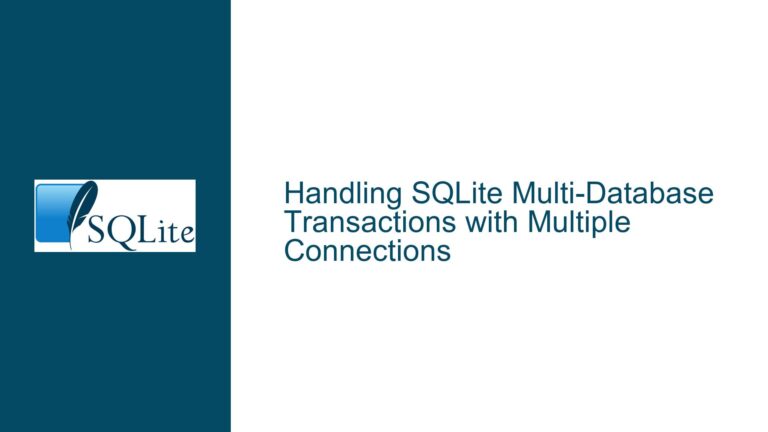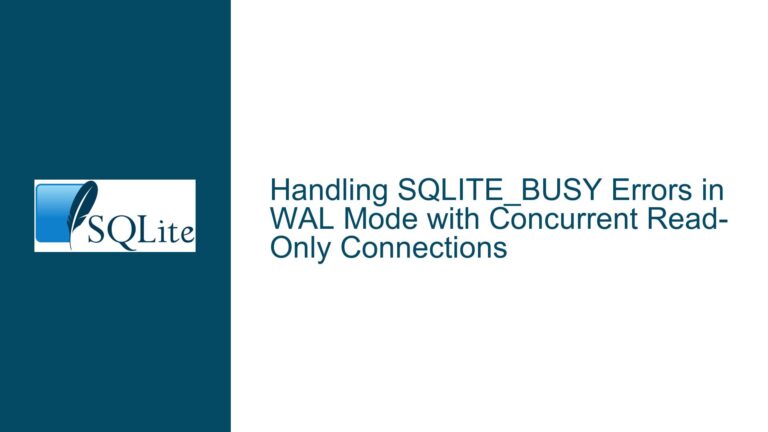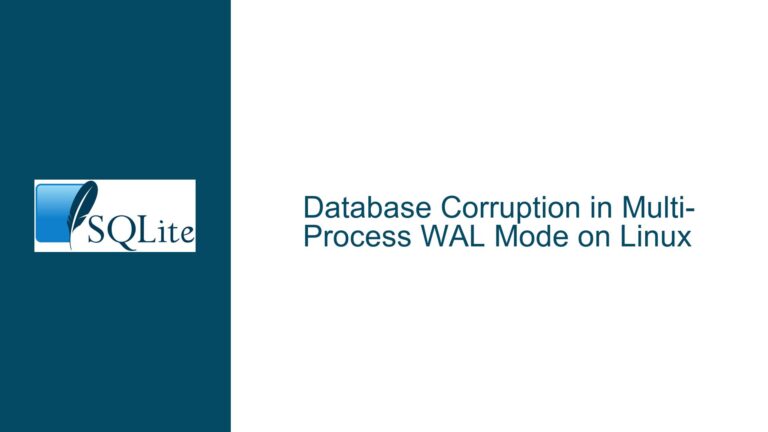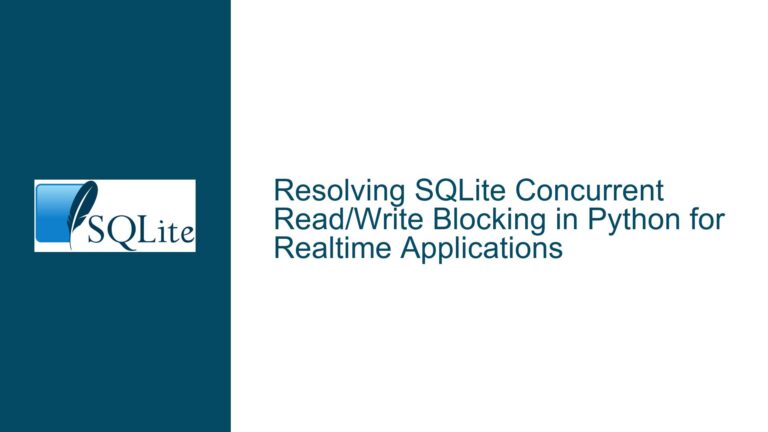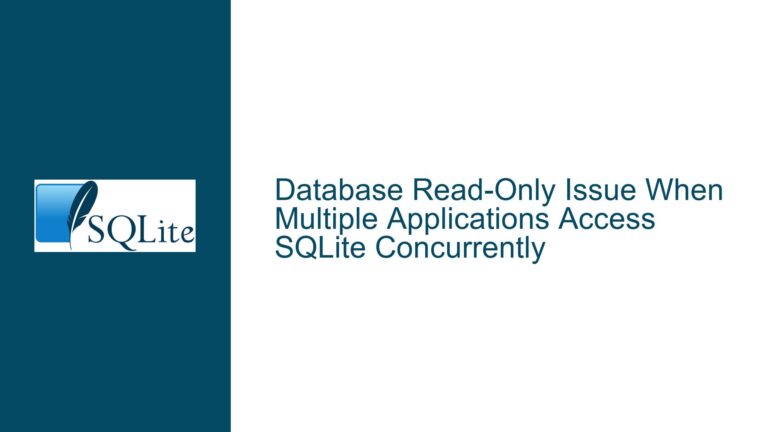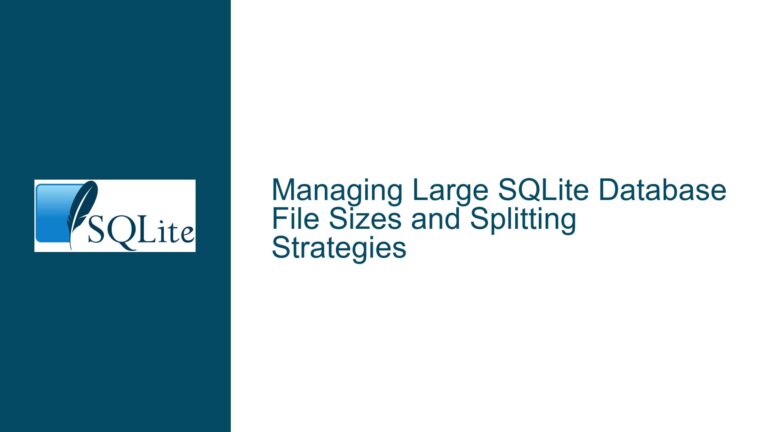Master-Master Replication in SQLite: Challenges and Solutions
Understanding Master-Master Replication in SQLite
Master-master replication, also known as bidirectional replication, is a database replication technique where two or more databases (referred to as "masters") can accept read and write operations independently. Changes made in one master are propagated to the other master(s), ensuring data consistency across all nodes. This setup is particularly useful in distributed systems where high availability and fault tolerance are critical. However, SQLite, being a lightweight, serverless, and file-based database, does not natively support master-master replication. This limitation stems from SQLite’s design philosophy, which prioritizes simplicity and embedded use cases over complex distributed architectures.
SQLite operates on a single file, and its concurrency model is based on file-level locking. This means that only one write operation can occur at a time, and simultaneous writes from multiple masters would lead to conflicts. Unlike client-server databases such as MySQL or PostgreSQL, SQLite lacks built-in mechanisms for handling distributed transactions or conflict resolution, which are essential for master-master replication. Therefore, implementing master-master replication in SQLite requires external tools, extensions, or custom solutions to manage data synchronization and conflict resolution.
The Session Extension, mentioned in the discussion, is one such tool that can facilitate partial replication by tracking changes to specific tables and exporting them to other databases. However, the Session Extension is not a full-fledged replication solution and has limitations, such as the inability to handle schema changes or complex conflict resolution scenarios. This makes it unsuitable for robust master-master replication setups. To achieve true master-master replication in SQLite, a combination of custom scripting, third-party tools, and careful schema design is often necessary.
Challenges in Implementing Master-Master Replication with SQLite
The primary challenge in implementing master-master replication with SQLite lies in its architecture. SQLite is designed for single-user or low-concurrency environments, making it inherently unsuitable for distributed systems where multiple nodes need to read and write simultaneously. The lack of a built-in replication mechanism means that developers must rely on external tools or custom solutions, which can introduce complexity and potential points of failure.
One major challenge is conflict resolution. In a master-master setup, the same record might be modified simultaneously in different masters, leading to conflicts. Resolving these conflicts requires a well-defined strategy, such as "last write wins," manual intervention, or application-level logic. SQLite does not provide native support for conflict resolution, so developers must implement this functionality themselves. This can be error-prone and time-consuming, especially in systems with high write throughput.
Another challenge is ensuring data consistency across all nodes. In a distributed system, network latency, partitions, and node failures can lead to inconsistencies. SQLite’s file-based nature exacerbates this issue, as changes must be propagated manually or through external tools. Ensuring atomicity and durability in such a setup is non-trivial and often requires additional layers of abstraction, such as message queues or distributed locks.
Performance is also a concern. SQLite’s file-level locking can become a bottleneck in high-concurrency environments, especially when multiple masters attempt to write simultaneously. This can lead to contention and reduced throughput. While workarounds such as partitioning the database or using multiple SQLite files can mitigate this issue, they add complexity and may not scale well.
Finally, schema changes pose a significant challenge. In a master-master setup, schema modifications (e.g., adding or dropping columns) must be propagated to all nodes consistently. SQLite does not provide built-in support for schema synchronization, so developers must implement custom mechanisms to handle schema changes. This can be particularly challenging in systems with frequent schema updates.
Strategies for Implementing Master-Master Replication in SQLite
Given the challenges outlined above, implementing master-master replication in SQLite requires a combination of tools, techniques, and best practices. Below are some strategies to achieve this:
Using the Session Extension for Partial Replication: The Session Extension can be used to track changes to specific tables and export them to other databases. While this does not provide full master-master replication, it can be useful for scenarios where only a subset of tables needs to be synchronized. The Session Extension works by creating a "changeset" that contains the differences between two database states. This changeset can then be applied to another database to synchronize data. However, the Session Extension has limitations, such as the inability to handle schema changes or complex conflict resolution. Therefore, it is best suited for simple use cases where data conflicts are rare or can be resolved manually.
Custom Replication with Triggers and Log Tables: Another approach is to use SQLite triggers to log changes to a separate table, which can then be propagated to other nodes. For example, you can create triggers on each table that insert a record into a log table whenever a row is inserted, updated, or deleted. These log entries can then be processed by a custom script or application to apply the changes to other databases. This approach provides more control over the replication process but requires significant development effort and careful handling of conflicts.
Third-Party Tools and Libraries: Several third-party tools and libraries can facilitate replication in SQLite. For example, Litestream is a tool that provides continuous replication of SQLite databases to cloud storage, enabling disaster recovery and read scalability. While Litestream is not a full master-master replication solution, it can be combined with other techniques to achieve bidirectional replication. Another option is rqlite, which provides a distributed SQLite database with leader-follower replication. Although rqlite does not support master-master replication out of the box, it can be adapted for this purpose with custom logic.
Application-Level Replication: In some cases, replication can be handled at the application level rather than the database level. For example, an application can be designed to write changes to multiple SQLite databases simultaneously or use a message queue to propagate changes between nodes. This approach provides maximum flexibility but requires careful design to ensure data consistency and handle conflicts.
Partitioning and Sharding: To reduce contention and improve performance, the database can be partitioned or sharded across multiple SQLite files. Each partition or shard can be replicated independently, reducing the likelihood of conflicts and improving scalability. However, this approach adds complexity and may require changes to the application logic to handle distributed queries.
Conflict Resolution Strategies: Implementing a robust conflict resolution strategy is critical for master-master replication. Common strategies include "last write wins," where the most recent change overwrites previous ones; manual intervention, where conflicts are flagged for human review; and application-level logic, where business rules determine how conflicts should be resolved. The choice of strategy depends on the specific requirements of the system and the nature of the data.
Schema Synchronization: To handle schema changes, a custom mechanism must be implemented to propagate schema modifications to all nodes. This can be done using a versioning system, where each schema change is assigned a version number and applied sequentially to all databases. Alternatively, schema changes can be logged and propagated using a similar approach to data replication.
Step-by-Step Guide to Implementing Master-Master Replication in SQLite
Below is a detailed guide to implementing master-master replication in SQLite using a combination of the Session Extension and custom scripting:
Install the Session Extension: Download and compile the Session Extension from the SQLite website. Load the extension in your SQLite environment using the
load_extensionfunction. Ensure that the extension is enabled for all databases involved in the replication setup.Enable Change Tracking: Use the
sqlite3sessionAPI to enable change tracking for the tables you want to replicate. This involves creating a session object and attaching it to the database. Configure the session to track inserts, updates, and deletes.Generate and Apply Changesets: Periodically generate changesets from the session object, which contain the differences between the current database state and the state at the last synchronization point. Apply these changesets to the other database(s) using the
sqlite3changeset_applyfunction. Handle any conflicts that arise during the application process.Implement Conflict Resolution: Define a conflict resolution strategy based on your application’s requirements. For example, you can use "last write wins" or implement custom logic to resolve conflicts. Log any unresolved conflicts for manual review.
Automate the Replication Process: Use a script or application to automate the generation and application of changesets. Schedule this process to run at regular intervals or trigger it based on specific events, such as a certain number of changes being made.
Monitor and Maintain the Replication Setup: Regularly monitor the replication process to ensure data consistency and identify any issues. Implement logging and alerting to detect and resolve problems quickly. Periodically review and optimize the replication setup to improve performance and reliability.
Handle Schema Changes: Implement a versioning system for schema changes. When a schema change is made, increment the version number and apply the change to all databases. Use the Session Extension to track and propagate schema changes if necessary.
Test the Replication Setup: Thoroughly test the replication setup under various scenarios, including high concurrency, network failures, and conflicting changes. Ensure that data consistency is maintained and that conflicts are resolved according to the defined strategy.
By following these steps, you can implement a robust master-master replication setup in SQLite. While this approach requires significant effort and careful planning, it provides a viable solution for scenarios where SQLite’s simplicity and lightweight nature are advantageous.

